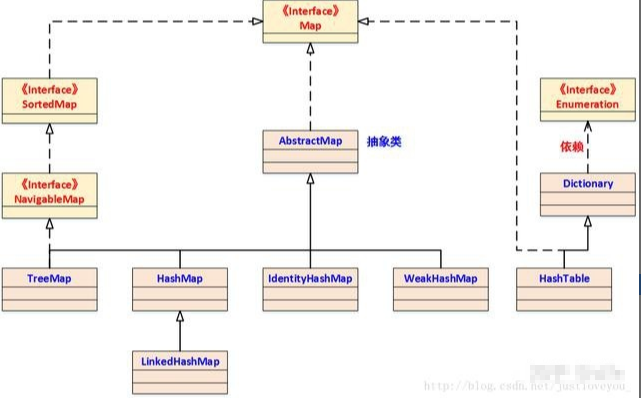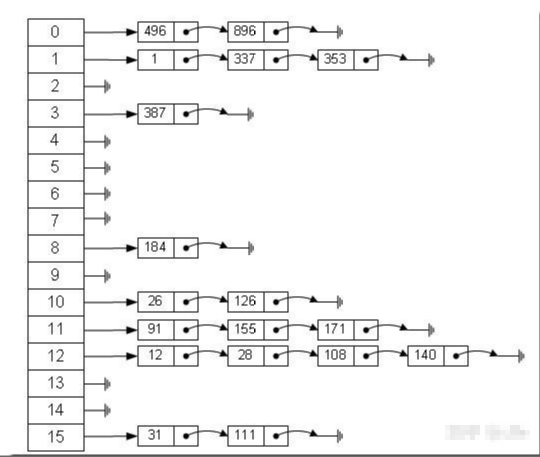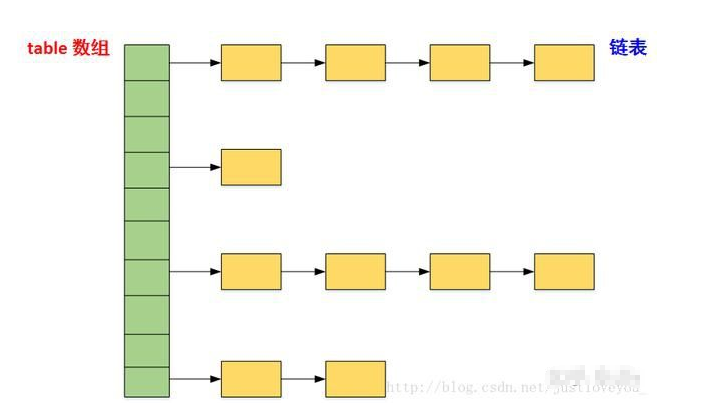寫在前面
HashMap是Map族中最爲常用的一種,也是 Java Collection Framework 的重要成員。本文首先給出了 HashMap 的實質並概述了其與 Map、HashSet 的關係,緊接着給出了 HashMap 在 JDK 中的定義,並結合源碼分析了其四種構造方式。最後,通過對 HashMap 的數據結構、實現原理、源碼實現三個方面的剖析,深入到它底層 Hash 存儲機制,解釋了其底層數組長度總是 2 的 n 次方的原因,也揭示了其快速存取、擴容及擴容後的重哈希的原理與實現。
本文所有關於HashMap的源碼都是基於 JDK 1.6 的,不同 JDK 版本之間也許會有些許差異,但不影響我們對 HashMap 的數據結構、原理等整體的把握和了解。
HashMap 概述
Map 是 Key-Value 對映射的抽象接口,該映射不包括重複的鍵,即一個鍵對應一個值。HashMap 是 Java Collection Framework 的重要成員,也是Map族(如下圖所示)中我們最爲常用的一種。簡單地說,HashMap 是基於哈希表的 Map 接口的實現,以 Key-Value 的形式存在,即存儲的對象是 Entry (同時包含了 Key 和 Value) 。在HashMap中,其會根據hash算法來計算key-value的存儲位置並進行快速存取。特別地,HashMap最多隻允許一條Entry的鍵爲Null(多條會覆蓋),但允許多條Entry的值爲Null。此外,HashMap 是 Map 的一個非同步的實現。
雖然 HashMap 和 HashSet 實現的接口規範不同,但是它們底層的 Hash 存儲機制完全相同。實際上,HashSet 本身就是在 HashMap 的基礎上實現的
HashMap 在 JDK 中的定義
HashMap實現了Map接口,並繼承 AbstractMap 抽象類,其中 Map 接口定義了鍵值映射規則。和 AbstractCollection抽象類在 Collection 族的作用類似, AbstractMap 抽象類提供了 Map 接口的骨幹實現,以最大限度地減少實現Map接口所需的工作。HashMap 在JDK中的定義爲:
public class HashMap<K, V> extends AbstractMap<K, V>implements Map<K, V>, Cloneable, Serializable {
...}HashMap 的構造函數
HashMap 一共提供了四個構造函數,其中 默認無參的構造函數 和 參數爲Map的構造函數 爲 Java Collection Framework 規範的推薦實現,其餘兩個構造函數則是 HashMap 專門提供的。
1、HashMap()
該構造函數意在構造一個具有> 默認初始容量 (16) 和 默認負載因子(0.75) 的空 HashMap,是 Java Collection Framework 規範推薦提供的,其源碼如下:
/** * Constructs an empty HashMap with the default initial capacity * (16) and the default load factor (0.75). */
public HashMap() {
//負載因子:用於衡量的是一個散列表的空間的使用程度 this.loadFactor = DEFAULT_LOAD_FACTOR;
//HashMap進行擴容的閾值,它的值等於 HashMap 的容量乘以負載因子 threshold = (int)(DEFAULT_INITIAL_CAPACITY * DEFAULT_LOAD_FACTOR);
// HashMap的底層實現仍是數組,只是數組的每一項都是一條鏈 table = new Entry[DEFAULT_INITIAL_CAPACITY];
init();
}2、HashMap(int initialCapacity, float loadFactor)
該構造函數意在構造一個 指定初始容量 和 指定負載因子的空 HashMap,其源碼如下:
/** * Constructs an empty HashMap with the specified initial capacity and load factor. */
public HashMap(int initialCapacity, float loadFactor) {
//初始容量不能小於 0 if (initialCapacity < 0)
throw new IllegalArgumentException("Illegal initial capacity: " + initialCapacity);
//初始容量不能超過 2^30 if (initialCapacity > MAXIMUM_CAPACITY)
initialCapacity = MAXIMUM_CAPACITY;
//負載因子不能小於 0
if (loadFactor <= 0 || Float.isNaN(loadFactor))
throw new IllegalArgumentException("Illegal load factor: " +
loadFactor);
// HashMap 的容量必須是2的冪次方,超過 initialCapacity 的最小 2^n
int capacity = 1;
while (capacity < initialCapacity)
capacity <<= 1;
//負載因子 this.loadFactor = loadFactor;
//設置HashMap的容量極限,當HashMap的容量達到該極限時就會進行自動擴容操作 threshold = (int)(capacity * loadFactor);
// HashMap的底層實現仍是數組,只是數組的每一項都是一條鏈 table = new Entry[capacity];
init();
}3、HashMap(int initialCapacity)
該構造函數意在構造一個指定初始容量和默認負載因子 (0.75)的空 HashMap,其源碼如下:
// Constructs an empty HashMap with the specified initial capacity and the default load factor (0.75) public HashMap(int initialCapacity) {
this(initialCapacity, DEFAULT_LOAD_FACTOR); // 直接調用上述構造函數 }4、HashMap(Map<? extends K, ? extends V> m)
該構造函數意在構造一個與指定 Map 具有相同映射的 HashMap,其 初始容量不小於 16 (具體依賴於指定Map的大小),負載因子是 0.75,是 Java Collection Framework 規範推薦提供的,其源碼如下:
// Constructs a new HashMap with the same mappings as the specified Map.
// The HashMap is created with default load factor (0.75) and an initial capacity // sufficient to hold the mappings in the specified Map. public HashMap(Map<? extends K, ? extends V> m) {
// 初始容量不小於 16
this(Math.max((int) (m.size() / DEFAULT_LOAD_FACTOR) + 1,
DEFAULT_INITIAL_CAPACITY), DEFAULT_LOAD_FACTOR);
putAllForCreate(m);
}在這裏,我們提到了兩個非常重要的參數:初始容量 和 負載因子,這兩個參數是影響HashMap性能的重要參數。其中,容量表示哈希表中桶的數量 (table 數組的大小),初始容量是創建哈希表時桶的數量;負載因子是哈希表在其容量自動增加之前可以達到多滿的一種尺度,它衡量的是一個散列表的空間的使用程度,負載因子越大表示散列表的裝填程度越高,反之愈小。
HashMap 的數據結構
哈希的相關概念
Hash 就是把任意長度的輸入(又叫做預映射, pre-image),通過哈希算法,變換成固定長度的輸出(通常是整型),該輸出就是哈希值。這種轉換是一種 壓縮映射 ,也就是說,散列值的空間通常遠小於輸入的空間。不同的輸入可能會散列成相同的輸出,從而不可能從散列值來唯一的確定輸入值。簡單的說,就是一種將任意長度的消息壓縮到某一固定長度的息摘要函數。
哈希的應用:數據結構
我們知道,數組的特點是:尋址容易,插入和刪除困難;而鏈表的特點是:尋址困難,插入和刪除容易。那麼我們能不能綜合兩者的特性,做出一種尋址容易,插入和刪除也容易的數據結構呢?答案是肯定的,這就是我們要提起的哈希表。事實上,哈希表有多種不同的實現方法,我們接下來解釋的是最經典的一種方法 —— 拉鍊法,我們可以將其理解爲 鏈表的數組,如下圖所示:
我們可以從上圖看到,左邊很明顯是個數組,數組的每個成員是一個鏈表。該數據結構所容納的所有元素均包含一個指針,用於元素間的鏈接。我們根據元素的自身特徵把元素分配到不同的鏈表中去,反過來我們也正是通過這些特徵找到正確的鏈表,再從鏈表中找出正確的元素。其中,根據元素特徵計算元素數組下標的方法就是 哈希算法。
總的來說,哈希表適合用作快速查找、刪除的基本數據結構,通常需要總數據量可以放入內存。在使用哈希表時,有以下幾個關鍵點:
hash 函數(哈希算法)的選擇:針對不同的對象(字符串、整數等)具體的哈希方法;
碰撞處理:常用的有兩種方式,一種是open hashing,即 >拉鍊法;
另一種就是 closed hashing,即開地址法(opened addressing)。
HashMap 的數據結構
我們知道,在Java中最常用的兩種結構是 數組 和 鏈表,幾乎所有的數據結構都可以利用這兩種來組合實現,HashMap 就是這種應用的一個典型。實際上,HashMap 就是一個 鏈表數組,如下是它數據結構:
從上圖中,我們可以形象地看出HashMap底層實現還是數組,只是數組的每一項都是一條鏈。其中參數initialCapacity 就代表了該數組的長度,也就是桶的個數。在第三節我們已經瞭解了HashMap 的默認構造函數的源碼:
/** * Constructs an empty HashMap with the default initial capacity * (16) and the default load factor (0.75). */
public HashMap() {
//負載因子:用於衡量的是一個散列表的空間的使用程度 this.loadFactor = DEFAULT_LOAD_FACTOR;
//HashMap進行擴容的閾值,它的值等於 HashMap 的容量乘以負載因子 threshold = (int)(DEFAULT_INITIAL_CAPACITY * DEFAULT_LOAD_FACTOR);
// HashMap的底層實現仍是數組,只是數組的每一項都是一條鏈 table = new Entry[DEFAULT_INITIAL_CAPACITY];
init();
}從上述源碼中我們可以看出,每次新建一個HashMap時,都會初始化一個Entry類型的table數組,其中 Entry類型的定義如下:
static class Entry<K,V> implements Map.Entry<K,V> {
final K key; // 鍵值對的鍵 V value; // 鍵值對的值 Entry<K,V> next; // 下一個節點 final int hash; // hash(key.hashCode())方法的返回值 /** * Creates new entry. */
Entry(int h, K k, V v, Entry<K,V> n) { // Entry 的構造函數 value = v;
next = n;
key = k;
hash = h;
}
......}其中,Entry爲HashMap的內部類,實現了 Map.Entry 接口,其包含了鍵key、值value、下一個節點next,以及hash值四個屬性。事實上,Entry 是構成哈希表的基石,是哈希表所存儲的元素的具體形式。
HashMap 的快速存取
下面我們結合JDK源碼看HashMap 的存取實現。
HashMap 的存儲實現
在 HashMap 中,鍵值對的存儲是通過 put(key,vlaue) 方法來實現的,其源碼如下:
/** * Associates the specified value with the specified key in this map. * If the map previously contained a mapping for the key, the old * value is replaced. * * @param key key with which the specified value is to be associated * @param value value to be associated with the specified key * @return the previous value associated with key, or null if there was no mapping for key. * Note that a null return can also indicate that the map previously associated null with key. */
public V put(K key, V value) {
//當key爲null時,調用putForNullKey方法,並將該鍵值對保存到table的第一個位置
if (key == null)
return putForNullKey(value);
//根據key的hashCode計算hash值 int hash = hash(key.hashCode()); // ------- (1) //計算該鍵值對在數組中的存儲位置(哪個桶) int i = indexFor(hash, table.length); // ------- (2) //在table的第i個桶上進行迭代,尋找 key 保存的位置 for (Entry<K,V> e = table[i]; e != null; e = e.next) { // ------- (3) Object k;
//判斷該條鏈上是否存在hash值相同且key值相等的映射,若存在,則直接覆蓋 value,並返回舊value if (e.hash == hash && ((k = e.key) == key || key.equals(k))) {
V oldValue = e.value;
e.value = value;
e.recordAccess(this);
return oldValue; // 返回舊值 }
}
modCount++; //修改次數增加1,快速失敗機制 //原HashMap中無該映射,將該添加至該鏈的鏈頭 addEntry(hash, key, value, i);
return null;
}對NULL鍵的特別處理:putForNullKey()
我們直接看其源碼:
/** * Offloaded version of put for null keys */
private V putForNullKey(V value) {
// 若key==null,則將其放入table的第一個桶,即 table[0] for (Entry<K,V> e = table[0]; e != null; e = e.next) {
if (e.key == null) { // 若已經存在key爲null的鍵,則替換其值,並返回舊值 V oldValue = e.value;
e.value = value;
e.recordAccess(this);
return oldValue;
}
}
modCount++; // 快速失敗 addEntry(0, null, value, 0); // 否則,將其添加到 table[0] 的桶中 return null;
}HashMap 中的哈希策略(算法)
/**
* Applies a supplemental hash function to a given hashCode, which
* defends against poor quality hash functions. This is critical
* because HashMap uses power-of-two length hash tables, that
* otherwise encounter collisions for hashCodes that do not differ
* in lower bits.
*
* Note: Null keys always map to hash 0, thus index 0.
*/
static int hash( int h )
{
/*
* This function ensures that hashCodes that differ only by
* constant multiples at each bit position have a bounded
* number of collisions (approximately 8 at default load factor).
*/
h ^= (h >>> 20) ^ (h >>> 12);
return(h ^ (h >>> 7) ^ (h >>> 4) );
}正如JDK官方對該方法的描述那樣,使用hash()方法對一個對象的hashCode進行重新計算是爲了防止質量低下的hashCode()函數實現。由於hashMap的支撐數組長度總是 2 的冪次,通過右移可以使低位的數據儘量的不同,從而使hash值的分佈儘量均勻。
通過上述hash()方法計算得到 Key 的 hash值 後,怎麼才能保證元素均勻分佈到table的每個桶中呢?我們會想到取模,但是由於取模的效率較低,HashMap 是通過調用上面的indexFor()方法處理的,其不但簡單而且效率很高,對應源碼如下所示:
/** * * Returns index for hash code h. * */static int indexFor( int h, int length ){
return(h & (length - 1) ); /* 作用等價於取模運算,但這種方式效率更高 */}HashMap 中鍵值對的添加:addEntry()
我們直接看其源碼:
/** * Adds a new entry with the specified key, value and hash code to * the specified bucket. It is the responsibility of this * method to resize the table if appropriate. * * Subclass overrides this to alter the behavior of put method. *
* 永遠都是在鏈表的表頭添加新元素 */
void addEntry(int hash, K key, V value, int bucketIndex) {
//獲取bucketIndex處的鏈表 Entry<K,V> e = table[bucketIndex];
//將新創建的 Entry 鏈入 bucketIndex處的鏈表的表頭
table[bucketIndex] = new Entry<K,V>(hash, key, value, e);
//若HashMap中元素的個數超過極限值 threshold,則容量擴大兩倍 if (size++ >= threshold)
resize(2 * table.length);
}HashMap 的擴容:resize()
隨着HashMap中元素的數量越來越多,發生碰撞的概率將越來越大,所產生的子鏈長度就會越來越長,這樣勢必會影響HashMap的存取速度。爲了保證HashMap的效率,系統必須要在某個臨界點進行擴容處理,該臨界點就是HashMap中元素的數量在數值上等於threshold(table數組長度*加載因子)。但是,不得不說,擴容是一個非常耗時的過程,因爲它需要重新計算這些元素在新table數組中的位置並進行復制處理。所以,如果我們能夠提前預知HashMap 中元素的個數,那麼在構造HashMap時預設元素的個數能夠有效的提高HashMap的性能。我們直接看其源碼:
/** * * Rehashes the contents of this map into a new array with a * * larger capacity. This method is called automatically when the * * number of keys in this map reaches its threshold. * * * * If current capacity is MAXIMUM_CAPACITY, this method does not * * resize the map, but sets threshold to Integer.MAX_VALUE. * * This has the effect of preventing future calls. * * * * @param newCapacity the new capacity, MUST be a power of two; * * must be greater than current capacity unless current * * capacity is MAXIMUM_CAPACITY (in which case value * * is irrelevant). * */void resize( int newCapacity ){
Entry[] oldTable = table;
int oldCapacity = oldTable.length;
/* 若 oldCapacity 已達到最大值,直接將 threshold 設爲 Integer.MAX_VALUE */
if ( oldCapacity == MAXIMUM_CAPACITY )
{
threshold = Integer.MAX_VALUE;
return; /* 直接返回 */
}
/* 否則,創建一個更大的數組 */
Entry[] newTable = new Entry[newCapacity];
/* 將每條Entry重新哈希到新的數組中 */
transfer( newTable );
table = newTable;
threshold = (int) (newCapacity * loadFactor); /* 重新設定 threshold */}HashMap 的重哈希:transfer()
重哈希的主要是一個重新計算原HashMap中的元素在新table數組中的位置並進行復制處理的過程,我們直接看其源碼:
/** * * Transfers all entries from current table to newTable. * */void transfer( Entry[] newTable ){/* 將原數組 table 賦給數組 src */
Entry[] src = table;
int newCapacity = newTable.length;/* 將數組 src 中的每條鏈重新添加到 newTable 中 */
for ( int j = 0; j < src.length; j++ )
{
Entry<K, V> e = src[j];
if ( e != null )
{
src[j] = null; /* src 回收 *//* 將每條鏈的每個元素依次添加到 newTable 中相應的桶中 */
do
{
Entry<K, V> next = e.next;/* e.hash指的是 hash(key.hashCode())的返回值; *//* 計算在newTable中的位置,注意原來在同一條子鏈上的元素可能被分配到不同的子鏈 */
int i = indexFor( e.hash, newCapacity );
e.next = newTable[i];
newTable[i] = e;
e = next;
}
while ( e != null );
}
}}特別需要注意的是,在重哈希的過程中,原屬於一個桶中的Entry對象可能被分到不同的桶,因爲HashMap 的容量發生了變化,那麼 h&(length - 1) 的值也會發生相應的變化。極端地說,如果重哈希後,原屬於一個桶中的Entry對象仍屬於同一桶,那麼重哈希也就失去了意義。
HashMap 的讀取實現
相對於HashMap的存儲而言,讀取就顯得比較簡單了。因爲,HashMap只需通過key的hash值定位到table數組的某個特定的桶,然後查找並返回該key對應的value即可,源碼如下:
/** * * Returns the value to which the specified key is mapped, * * or {@code null} if this map contains no mapping for the key. * * <p>More formally, if this map contains a mapping from a key * * {@code k} to a value {@code v} such that {@code (key==null ? k==null : * * key.equals(k))}, then this method returns {@code v}; otherwise * * it returns {@code null}. (There can be at most one such mapping.) * <p>A return value of {@code null} does not <i>necessarily</i> * * indicate that the map contains no mapping for the key; it's also * * possible that the map explicitly maps the key to {@code null}. * * The {@link #containsKey containsKey} operation may be used to * * distinguish these two cases. * @see #put(Object, Object) * */public V get( Object key ){/* 若爲null,調用getForNullKey方法返回相對應的value */
if ( key == null )/* 從table的第一個桶中尋找 key 爲 null 的映射;若不存在,直接返回null */
return(getForNullKey() );/* 根據該 key 的 hashCode 值計算它的 hash 碼 */
int hash = hash( key.hashCode() );/* 找出 table 數組中對應的桶 */
for ( Entry<K, V> e = table[indexFor( hash, table.length )];
e != null;
e = e.next )
{
Object k;/* 若搜索的key與查找的key相同,則返回相對應的value */
if ( e.hash == hash && ( (k = e.key) == key || key.equals( k ) ) )
return(e.value);
}
return(null);}針對鍵爲NULL的鍵值對,HashMap 提供了專門的處理:getForNullKey(),其源碼如下:
/** * * Offloaded version of get() to look up null keys. Null keys map * * to index 0. This null case is split out into separate methods * * for the sake of performance in the two most commonly used * * operations (get and put), but incorporated with conditionals in * * others. * */private V getForNullKey(){
/* 鍵爲NULL的鍵值對若存在,則必定在第一個桶中 */
for ( Entry<K, V> e = table[0]; e != null; e = e.next )
{
if ( e.key == null )
return(e.value);
}
/* 鍵爲NULL的鍵值對若不存在,則直接返回 null */
return(null);}因此,調用HashMap的get(Object key)方法後,若返回值是 NULL,則存在如下兩種可能:
該 key 對應的值就是 null;
HashMap 中不存在該 key。




